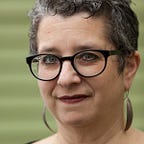What I learned about systemic racism at the doctor’s office
If you’ve never personally experienced institutional discrimination — racism, sexism, homophobia — there’s no way you can understand it. You can’t get how deep it goes, how irresistible it is. If you’ve never been the target of any kind of institutionalized stigma it’s easy to think each incident or encounter stands on its own. You believe each act of violence, physical or not, has its own origin story and its own specific solution.
But anyone who’s ever realized that the crappy treatment they got at a job, in a store, at the doctor’s office isn’t just about them but is part of a bigger picture knows just how wrong this is.
I’m a privileged white middle-class woman. I’ve never experienced racism. Anti-Semitism, yes. Misogyny, absolutely. But I’ve never had to worry about being harassed, arrested, beaten, killed because of the color of my skin, my sexual orientation, my country of origin. As a college professor, I teach classes in social identity theory, helping students understand the factors that makes us see others as inherently different and less-than. We talk about how we’re hard-wired to crave approval and acceptance from our tribe, and to see other tribes as inferior.
Still, I didn’t fully get how encompassing that kind of stigma could feel until I experienced it myself, at a visit to the pulmonologist. I’d been diagnosed with sleep apnea and was adjusting to using a CPAP at night. I expected a check in about how it was going. Instead, I got a lecture from the physician’s assistant about weight loss. “Thin people get sleep apnea too,” I reminded her, but she insisted that I needed to go on a diet immediately. I mentioned a study showing that people who used CPAPs regularly actually tend to gain weight. She shut me down.
The doctor who blew into the room next didn’t ask if I was using the machine or how I was doing but started right in on the weight-loss lecture. This time I was a little more forceful in interrupting him — not once or twice but three times. Finally he looked me up and down and said, “I guess you’re not that obese.”
I left that office feeling utterly humiliated and discouraged. I’d spent years working through a lot of body hatred. I recognized knee-jerk weight stigma when I saw it, and intellectually I understood it for what it was.
But here’s what all the theories and intellectual explanations in the world can’t explain: When your personal self-loathing is reinforced and magnified by the words of authority figures like doctors, journalists, politicians, cultural icons, it’s way more punishing. The consequences of discrimination are amplified a million times when they echo off the walls of the world we live in. It’s better to be white, to be thin, to have straight blond hair. When every institution you rely on is shouting the same message, you believe it. You can’t talk or think or process yourself out of it. In fact, you lose the will to even try.
The difference between personal, existential despair and being on the receiving end of institutionalized discrimination is something like the difference between a rash and smallpox. One is discrete if painful; the other overwhelms the whole system, paralyzes it, shuts it down. It’s impossible to breathe, to take in air, to have other thoughts. You’re flooded with shame, terror, despair and there is no way out — not in the moment and not after it passes, either. You’re in what Jordan Peele so eloquently called the sunken place. It’s both a metaphor for being marginalized and an accurate description of it.
For me, the connection I’d nurtured with my body broke down after that doctor’s visit. Years of a calm and stable relationship with food evaporated. I started restricting, eating as little as possible, as lightly as possible, trying to resist the hunger that began to color every waking hour, the guilt when I did eat, the despair when I stepped on the scale and saw I’d lost nothing or even gained weight. I was plunged right back into the cycle I’d spent my teens and 20s and 30s in, doubting everything I’d learned and come to understand. My trust in my body, its appetites, its needs, evaporated overnight. Ironically, I gained weight for the first time in 20 years.
I tell this story not to call out my experience as special but to make a bigger point about just how miraculous the last two weeks of protests have been. Thousands of people are calmly but forcefully standing up to cultural norms that are so deeply engrained they seem unquestionable. The last few years have seen outrage about specific incidents — the deaths of Eric Garner, Tamir Rice, Philando Castile, and many others. But the current protests are about more than the death of George Floyd, more than the indisputable fact that Black lives matter. These protesters are bearing public witness to a broken system. They’re maneuvering through the incapacitating despair of the sunken place with grace and courage and compassion. And they are being heard.
It is, quite simply, an extraordinary moment in history. We’ve seen protests against institutionalized racism before, of course, in the Civil Rights movement. But one thing that’s different here is that there is no Rosa Parks, no Martin Luther King, no Malcolm X, no charismatic leader to break the ice. The protests of the last two weeks have risen from the ground up, which makes them that much more meaningful.
Pushing back against institutional racism and other social inequities requires us to recognize how deeply we’ve internalized our culture’s values, whether we agree with them or not. As Ibram X. Kendi points out, it asks us to acknowledge the seemingly contradictory notions that we are both part of the problem and that it’s bigger than us alone. The same is certainly true about the solution.
